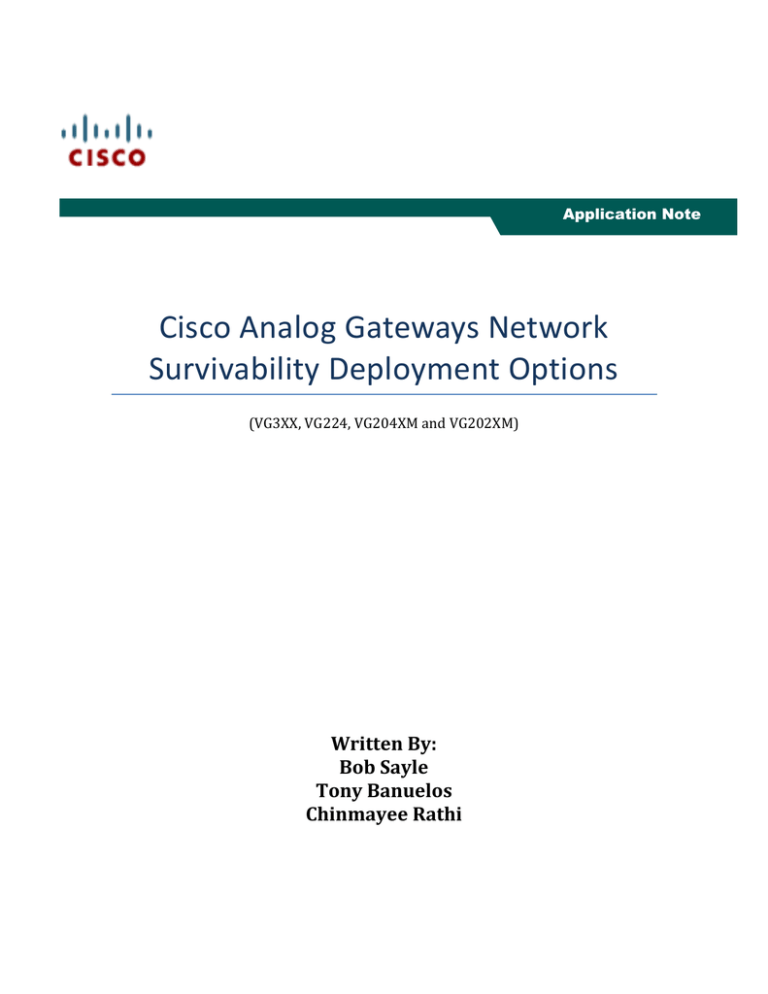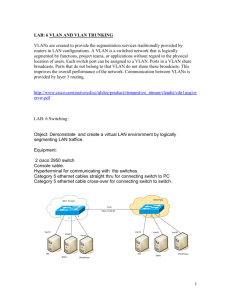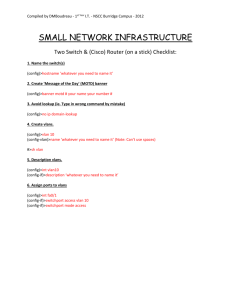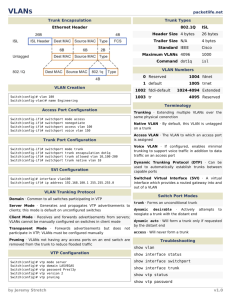Cisco Analog Gateways Network Survivability Deployment Options Written By:
advertisement

Application Note Cisco Analog Gateways Network Survivability Deployment Options (VG3XX, VG224, VG204XM and VG202XM) Written By: Bob Sayle Tony Banuelos Chinmayee Rathi Table of Contents Introduction ......................................................................................................................................... 3 Routed Survivability .......................................................................................................................... 4 Configuration................................................................................................................................... 4 Routed Survivability Option 1 – MGCP GW ............................................................................. 5 Routed Survivability Option 2 – SCCP GW .............................................................................21 Show Commands ......................................................................................................................... 37 Test Procedure ............................................................................................................................ 39 Debugging Tips ............................................................................................................................ 41 Running Configuration.............................................................................................................. 42 Bridged Survivability ..................................................................................................................... 47 Configuration................................................................................................................................ 47 Show Commands ......................................................................................................................... 63 Test Procedure ............................................................................................................................ 65 Debugging Tips ............................................................................................................................ 66 Running Configuration.............................................................................................................. 67 Introduction The Cisco VG series Analog Voice Gateways enable an IP telephony solution to continue using traditional analog devices while taking advantage of the productivity afforded by IP infrastructure. The Cisco VG series are Cisco IOS software-based analog phone gateways. They connect analog phones, fax machines, modems, and speakerphones to an enterprise voice system based on Cisco Unified Communications Manager (CUCM). The tight integration with the IPbased phone system is advantageous for increased manageability, scalability, and cost-effectiveness. Businesses can also use the Cisco VG series with Cisco Unified Communications Manager Express (CME) or Cisco Unified Communications Manager to effectively augment an integrated services router (ISR) environment. In this application note we are going to talk about the network survivability options that can be provided when you deploy a VG series in your network. There are two redundancy options available for VG deployments: • • Routed survivability, where the VG could use either MGCP or SCCP signaling to CUCM and leverages L3 equal cost multi-pathing (ECMP) for fast link failover. Bridged survivability, where the VG uses SCCP signaling to CUCM and relies on spanning tree for link failover. By providing redundancy, there is always at least one active link to the call control agent, which could be a CUCM or CME, to preserve active calls in case of link failure. Routed Survivability Routed survivability uses the VGs capability to be controlled as an MGCP or SCCP gateway and use L3 ECMP for fast link failover. The VG registers itself to the CUCM as an MGCP or SCCP gateway and uses its physical connections to create redundant paths. The VG’s loopback interface is used to register to the CUCM. Because the loopback interface is virtual, it always stays active. In case a physical link fails, the VG remains registered to the CUCM and preserves active calls by switching them to a redundant port. Configuration Overview 1. 2. 3. 4. Create three IP subnets on the switch. Connect the gigabit interfaces on the VG to subnets 1 and 2. Connect CUCM to subnet 3. Create a loopback interface on the VG. This is the interface used by the VG to register itself as an MGCP or SCCP gateway to the CUCM. 5. Enable MGCP or SCCP on the VG. 6. Enable EIGRP on the switch and the VG. After the topology converges there will be redundant paths to the CUCM. Now if a port on the VG loses connectivity, active calls switch to the other link and are preserved. Routed Survivability Option 1 – MGCP GW On the VG350: Step 1 – Configure IP addresses for the physical Ethernet interfaces. VG350(config)#interface GigabitEthernet0/1 VG350(config-if)#ip address 10.197.51.2 255.255.255.0 VG350(config-if)#no shut VG350(config-if)#exit VG350(config)#interface GigabitEthernet0/2 VG350(config-if)#ip address 10.197.52.2 255.255.255.0 VG350(config-if)#no shut Step 2 – Configure a loopback interface. VG350(config)# VG350(config)#interface Loopback0 VG350(config-if)#ip address 10.197.50.2 255.255.255.0 VG350(config-if)#no shut Step 3 – Enable EIGRP. 1 VG350(config)#router eigrp 20 VG350(config-router)#network 10.0.0.0 VG350(config-router)#eigrp stub connected summary Step 4 – Create a hostname mapping for the CUCM. VG350(config)#ip host CUCM90 172.19.153.139 The VG needs to advertise the 10.X.X.X IP subnets that are connected to the switch so enable EIGRP for this network. 1 Step 5.1 – Enable MGCP. VG350(config)#mgcp VG350(config)#mgcp call-agent CUCM90 2427 service-type mgcp version 0.1 VG350(config)#mgcp bind control source-interface Loopback0 VG350(config)#mgcp bind media source-interface Loopback0 VG350(config)#ccm-manager mgcp Explanation: 1. ‘mgcp call-agent CUCM90 2427 service-type mgcp version 0.1’ • Specifies the call agent’s name or IP address. This example uses ‘CUCM90’ as the call agent name. • Specifies call agent address UDP port number. For MGCP the standard port number is 2427. • Specifies the ‘service-type’ as ‘MGCP’. • Specifies the version as ‘0.1’. 2. ‘mgcp bind control source-interface Loopback0’ • Binds the control traffic to the loopback interface, which is why this interface is used to register to the CUCM. 3. ‘mgcp bind media source-interface Loopback0’ • Binds the media traffic to the loopback interface. 4. ‘ccm-manager mgcp’ • Enables Call Manager Application in MGCP mode. Step 5.2 – Configure analog ports to use MGCP. VG350(config)#dial-peer voice 1000 pots VG350(config-dial-peer)#service MGCPAPP VG350(config-dial-peer)#port 4/0/25 Explanation: 1. ‘service MGCPAPP’ • Enables MGCP application on the dial peer. • Configuration tip – ‘MGCPAPP’ is case sensitive. Configuration Tip: • Dial peer needs to be created for every port and this can be done with ease using the ‘dial peer group’ CLI enhancement. VG350(config)#dial-peer group 1 VG350(config-dial-peer)#service MGCPAPP VG350(config-dial-peer)#port 4/0/0 -71 1 On the switch: Step 1 – Configure three IP subnets. Step 1.1 – Add VLANs in the database. Switch#vlan database Switch(vlan)#vlan 10 VLAN 10 added: Name: VLAN0010 Switch(vlan)#vlan 20 VLAN 20 added: Name: VLAN0020 Switch(vlan)#vlan 30 VLAN 30 added: Name: VLAN0030 Step 1.2 – Create SVIs for the VLANs created previously. Switch(config)#interface Vlan10 Switch(config-if)#ip address 10.197.51.1 255.255.255.0 Switch(config-if)#exit Switch(config)#interface Vlan20 Switch(config-if)# ip address 10.197.52.1 255.255.255.0 Switch(config)#interface Vlan30 Switch(config-if)# ip address 172.19.153.1 255.255.255.0 Step 1.3 – Add switch ports to the VLANs. Switch(config)#interface FastEthernet0/1 Switch(config-if)#switchport host Switch(config-if)#switchport access vlan 10 Switch(config-if)#exit Switch(config)#interface FastEthernet0/2 Switch(config-if)#switchport host Switch(config-if)#switchport access vlan 20 Switch(config)#interface FastEthernet0/3 Switch(config-if)#switchport host Switch(config-if)#switchport access vlan 30 Switch(config-if)#exit Step 2 – Enable EIGRP. 2 Switch(config)#router eigrp 20 Switch(config-router)# network 10.0.0.0 Switch(config-router)# network 172.19.0.0 The switch needs to advertise the 10.X.X.X IP subnets connected to the VG and the 172.19.X.X subnet connected to the CUCM so enable EIGRP for these two networks. 2 On the CUCM: Step 1 – Register the VG350 as an MGCP gateway. Step 1.1 – Device -> Gateway -> Add New Step 1.2 – Select Gateway Type as ‘VG350’ and press ‘Next’. Step 1.3 – Select Protocol as ‘MGCP’ and press ‘Next’. Step 1.4 – Add the ‘Domain Name’ and the ‘Cisco Unified Communications Manager Group’. In this example it is set to ‘Default’. Leave the other properties to their default values. ‘Save’ the profile and ‘Apply the Configuration’. Step 2 – Configure the network module on the MGCP gateway. Step 2.1 – Select the appropriate slot. This example uses ‘Slot 4’ in ‘Analog’ mode. Save’ the profile and ‘Apply the Configuration’. Step 2.2 – Select the appropriate ‘Subunit’. This example uses Subunit 0 to ‘SM-D72FXS’. ‘Save’ the profile and ‘Apply the Configuration’ Step 3 – Configure the analog port. Step 3.1 – Select the appropriate port and click on it. This example uses ‘Port 4/25’. Step 3.2 – Select ‘Loop Start’ and click ‘Next’. Step 3.3 – Configure the appropriate ‘Device Pool’ and ‘Attendant DN’. Leave the other properties to their default values. ‘Save’ the profile and ‘Apply the Configuration’. Step 3.4 – Add the ‘Directory Number Information’. Click on ‘Line [1] – Add a new DN’. Now configure the ‘Directory Number’. Leave the other properties to their default values. ‘Save’ the profile and ‘Apply the Configuration’. Step 3.5 – Go back to the port page to check that the port is registered to the CUCM. Ensure that the port is ‘Registered with Cisco Unified Communications Manager’. Routed Survivability Option 2 – SCCP GW: On the VG350: Step 1 – Configure IP addresses for the physical Ethernet interfaces. VG350(config)#interface GigabitEthernet0/1 VG350(config-if)#ip address 10.197.51.2 255.255.255.0 VG350(config-if)#no shut VG350(config-if)#exit VG350(config)#interface GigabitEthernet0/2 VG350(config-if)#ip address 10.197.52.2 255.255.255.0 VG350(config-if)#no shut Step 2 – Configure a loopback interface. VG350(config)# VG350(config)#interface Loopback0 VG350(config-if)#ip address 10.197.50.2 255.255.255.0 VG350(config-if)#no shut Step 3 – Enable EIGRP. 3 VG350(config)#router eigrp 20 VG350(config-router)#network 10.0.0.0 VG350(config-router)#eigrp stub connected summary Step 4 – Create a hostname mapping for the CUCM. VG350(config)#ip host CUCM90 172.19.153.139 The VG needs to advertise the 10.X.X.X IP subnets that are connected to the switch so enable EIGRP for this network. 3 Step 5.1 – Enable SCCP. VG350(config)#sccp local Loopback0 VG350(config)#sccp ccm 172.19.153.139 identifier 1 version 7.0 VG350(config)#sccp VG350(config)#sccp ccm group 1 VG350(config-sccp-ccm)#associate ccm 1 priority 1 VG350(config-sccp-ccm)#bind interface Loopback0 VG350(config-sccp-ccm)#exit Explanation: 1. ‘sccp local Loopback0’ • Forces SCCP to use the Loopback0 interface for its communication to the CUCM. 2. ‘sccp ccm 172.19.153.139 identifier 1 version 7.0’ • Specifies the call agent’s IP address. This example uses ‘172.19.153.139’. • Specifies the call agent’s identifier. This example uses ‘1’. • Specifies the call agent’s version. This example uses ‘7’. 3. ‘sccp ccm group 1’ • Creates a SCCP group with identifier ‘1’. 4. ‘associate ccm 1 priority 1’ • Under the ‘sccp ccm group 1’, associate a CUCM with priority 1. 5. ‘bind interface Loopback0’ • Under the ‘sccp ccm group 1’, binds the Loopback0 interface to the SCCP group. Step 5.2 – Enable SCCP control of analog ports. VG350(config)#stcapp ccm-group 1 VG350(config)#stcapp Explanation: 1. ‘stcapp ccm-group 1’ • Specifies the STCAPP Call Manager group id. This example uses ‘1’. 2. ‘stcapp’ • Starts the SCCP Telephony Control Application. Step 5.3 – Configure analog port to use SCCP. VG350(config)#dial-peer voice 1 pots VG350(config-dial-peer)#service stcapp VG350(config-dial-peer)#port 4/0/24 Explanation: 1. ‘service stcapp’ • Enables ‘stcapp’ service on the dial peer. Configuration Tip: • Dial peer needs to be created for every port and this can be done easily using the ‘dial peer group’ CLI enhancement. VG350(config)#dial-peer group 1 VG350(config-dial-peer)#service stcapp VG350(config-dial-peer)#port 4/0/0 -71 1 Step 5.4 – Configure analog port. VG350(config)#voice-port 4/0/24 VG350(config-voiceport)#timeouts ringing infinity On the switch: Step 1 – Configure three IP subnets. Step 1.1 – Add VLANs in the database. Switch#vlan database Switch(vlan)#vlan 10 VLAN 10 added: Name: VLAN0010 Switch(vlan)#vlan 20 VLAN 20 added: Name: VLAN0020 Switch(vlan)#vlan 30 VLAN 30 added: Name: VLAN0030 Step 1.2 – Create SVIs for the VLANs created previously. Switch(config)#interface Vlan10 Switch(config-if)#ip address 10.197.51.1 255.255.255.0 Switch(config-if)#exit Switch(config)#interface Vlan20 Switch(config-if)# ip address 10.197.52.1 255.255.255.0 Switch(config)#interface Vlan30 Switch(config-if)# ip address 172.19.153.1 255.255.255.0 Step 1.3 – Add switch ports to the VLANs. Switch(config)#interface FastEthernet0/1 Switch(config-if)#switchport host Switch(config-if)#switchport access vlan 10 Switch(config-if)#exit Switch(config)#interface FastEthernet0/2 Switch(config-if)#switchport host Switch(config-if)#switchport access vlan 20 Switch(config)#interface FastEthernet0/3 Switch(config-if)#switchport host Switch(config-if)#switchport access vlan 30 Switch(config-if)#exit Step 2 – Enable EIGRP. 4 Switch(config)#router eigrp 20 Switch(config-router)# network 10.0.0.0 Switch(config-router)# network 172.19.0.0 The switch needs to advertise the 10.X.X.X IP subnets connected to the VG and the 172.19.X.X subnet connected to the CUCM so enable EIGRP for these two networks. 4 On the CUCM: Step 1 – Register the VG350 as an SCCP gateway. Step 1.1 – Device -> Gateway -> Add New Step 1.2 – Select Gateway Type as ‘VG350’ and press ‘Next’. Step 1.3 – Select Protocol as ‘SCCP’ and press ‘Next’. Step 1.4 – Add the last 10 characters of the VG’s Gigabit 0/0’s MAC address into the ‘MAC address’ field. In this example, the VG350’s Gigabit 0/0 address is 111122221111, therefore, ‘1122221111’ is entered. Set the ‘Cisco Unified Communications Manager Group’. In this example it is set to ‘Default’. Leave the other properties to their default values. ‘Save’ the profile and ‘Apply the Configuration’. Note: The VG will use the GE0/0 MAC address to create the SCCP MAC address identity (last 10 characters of the MAC address) This device id is used at layer7 (SCCP) to register the device on CUCM, no matter which L2/L3 interface is forwarding the SCCP signaling packet. Step 2 – Configure the network module on the SCCP gateway. Step 2.1 – Select the appropriate slot. This example uses ‘Slot 4’ in ‘Analog’ mode. ‘Save’ the profile and ‘Apply the Configuration’. Step 2.2 – Select the appropriate ‘Subunit’. This example uses Subunit 0 to ‘SM-D72FXS’. ‘Save’ the profile and ‘Apply the Configuration’. Step 3 – Configure the analog port. Step 3.1 – Select the appropriate port and click on it. This example uses ‘Port 4/24’. Step 3.2 – Set the appropriate values for: • • • • • • ‘Device Trust Mode’, this example uses ‘Not Trusted’. ‘Device pool’, this example uses ‘Not Trusted’. ‘Phone Button Template’, this example uses‘Standard Analog’. ‘Device Mobility Mode’, this example uses ‘Off’. ‘Owner’, this example uses ‘Anonymous’. ‘Device Security Profile’,this example uses ‘Analog Phone – Standard SCCP Non-Secure Profile’. Leave the other properties to their default values. ‘Save’ the profile and ‘Apply the Configuration’. Step 3.3 – Add the ‘Directory Number Information’. Click on ‘Line [1] – Add a new DN’. Now configure the ‘Directory Number’, this example uses ‘1000’. Leave the other properties to their default values. ‘Save’ the profile and ‘Apply the Configuration’. Step 3.4 – Go back to the port page to check that the port is registered to the CUCM. Ensure that the port is ‘Registered with Cisco Unified Communications Manager’. Show Commands On the VG350: VG350#show ip eigrp neighbors EIGRP-IPv4 Neighbors for AS(20) H Address Interface Hold Uptime SRTT RTO Q Seq (sec) (ms) Cnt Num 1 10.197.51.1 Gi0/1 13 04:36:33 1 4500 0 167 0 10.197.52.1 Gi0/2 12 04:40:02 5 100 0 169 VG350#show ip eigrp topology EIGRP-IPv4 Topology Table for AS(20)/ID(10.197.50.2) Codes: P - Passive, A - Active, U - Update, Q - Query, R - Reply, r - reply Status, s - sia Status P 172.19.153.0/24, 2 successors, FD is 30976 Redundant paths to via 10.197.51.1 (30976/28416), GigabitEthernet0/1 CUCM via 10.197.52.1 (30976/28416), GigabitEthernet0/2 VG350#show ip route Codes: L - local, C - connected, S - static, R - RIP, M - mobile, B - BGP D - EIGRP, EX - EIGRP external, O - OSPF, IA - OSPF inter area N1 - OSPF NSSA external type 1, N2 - OSPF NSSA external type 2 E1 - OSPF external type 1, E2 - OSPF external type 2 i - IS-IS, su - IS-IS summary, L1 - IS-IS level-1, L2 - IS-IS level-2 ia - IS-IS inter area, * - candidate default, U - per-user static route o - ODR, P - periodic downloaded static route, H - NHRP, l - LISP a - application route + - replicated route, % - next hop override Gateway of last resort is not set 10.0.0.0/8 is variably subnetted, 6 subnets, 2 masks 10.197.50.0/24 is directly connected, Loopback0 10.197.50.2/32 is directly connected, Loopback0 10.197.51.0/24 is directly connected, GigabitEthernet0/1 10.197.51.2/32 is directly connected, GigabitEthernet0/1 10.197.52.0/24 is directly connected, GigabitEthernet0/2 10.197.52.2/32 is directly connected, GigabitEthernet0/2 20.0.0.0/30 is subnetted, 1 subnets D 20.20.20.0 [90/28416] via 10.197.52.1, 04:44:33, GigabitEthernet0/2 [90/28416] via 10.197.51.1, 04:44:33, GigabitEthernet0/1 172.19.0.0/16 is variably subnetted, 8 subnets, 2 masks Redundant D 172.19.153.0/24 paths to [90/30976] via 10.197.52.1, 04:44:33, GigabitEthernet0/2 CUCM [90/30976] via 10.197.51.1, 04:44:33, GigabitEthernet0/1 C L C L C L On the switch: Switch#show ip eigrp neighbors EIGRP-IPv4 Neighbors for AS(20) H Address Interface Hold Uptime SRTT RTO Q Seq (sec) (ms) Cnt Num 2 10.197.51.2 Vl10 10 04:52:23 1 200 0 48 1 10.197.52.2 Vl20 14 04:55:52 331 1986 0 46 Switch#show ip eigrp topology EIGRP-IPv4 Topology Table for AS(20)/ID(172.19.153.27) Codes: P - Passive, A - Active, U - Update, Q - Query, R - Reply, r - reply Status, s - sia Status P 10.197.50.0/24, 2 successors, FD is 130816 via 10.197.51.2 (130816/128256), Vlan51 via 10.197.52.2 (130816/128256), Vlan52 Redundant paths to VG350 Switch#show ip route Codes: C - connected, S - static, R - RIP, M - mobile, B - BGP D - EIGRP, EX - EIGRP external, O - OSPF, IA - OSPF inter area N1 - OSPF NSSA external type 1, N2 - OSPF NSSA external type 2 E1 - OSPF external type 1, E2 - OSPF external type 2 i - IS-IS, su - IS-IS summary, L1 - IS-IS level-1, L2 - IS-IS level-2 ia - IS-IS inter area, * - candidate default, U - per-user static route o - ODR, P - periodic downloaded static route Gateway of last resort is not set D 10.197.50.0 [90/130816] via 10.197.52.2, 04:54:40, Vlan20 [90/130816] via 10.197.51.2, 04:54:40, Vlan10 Redundant paths to VG350 Test Procedure Step 1 – Call Phone 2 from Phone 1. Both interfaces on the VG350 are active and the call starts on Gig 0/1. VG350#show call active voice Telephony call-legs: 1 SIP call-legs: 0 H323 call-legs: 0 The call between Phone 1 Call agent controlled call-legs: 1 and Phone 2 is active. SCCP call-legs: 0 Multicast call-legs: 0 Total call-legs: 2 VG350#show ip interface brief Interface IP-Address Protocol GigabitEthernet0/1 10.197.51.2 GigabitEthernet0/2 10.197.52.2 Loopback0 10.197.50.2 OK? YES YES YES Method NVRAM NVRAM NVRAM Status up up up up up up Step 2 – Shutdown Gig 0/1 and notice that the EIGRP topology changes. The following messages are seen on the VG350. VG350# *Feb 7 21:22:11.565: %LINEPROTO-5-UPDOWN: Line protocol on Interface GigabitEthernet0/1, changed state to down *Feb 7 21:22:12.565: %LINK-3-UPDOWN: Interface GigabitEthernet0/1, changed state to down *Feb 7 21:22:12.565: %DUAL-5-NBRCHANGE: EIGRP-IPv4 20: Neighbor 10.197.51.1 (GigabitEthernet0/1) is down: interface down VG350#show ip eigrp topology EIGRP-IPv4 Topology Table for AS(20)/ID(10.197.50.2) Codes: P - Passive, A - Active, U - Update, Q - Query, R - Reply, r - reply Status, s - sia Status P 172.19.153.0/24, 1 successors, FD is 30976 via 10.197.52.1 (30976/28416), GigabitEthernet0/2 VG350#show call active voice Telephony call-legs: 1 SIP call-legs: 0 H323 call-legs: 0 Call agent controlled call-legs: 1 SCCP call-legs: 0 Multicast call-legs: 0 Total call-legs: 2 VG350 still has one active path to the CUCM and the call gets routed on to this active link. The call is active on the VG350 even after the first link Gig0/1 went down. VG350#show ip eigrp neighbors EIGRP-IPv4 Neighbors for AS(20) H Address Interface Hold Uptime SRTT RTO Q Seq (sec) (ms) Cnt Num 0 10.197.52.1 Gi0/2 13 00:02:03 6 100 0 159 VG350#show ip route Codes: L - local, C - connected, S - static, R - RIP, M - mobile, B - BGP D - EIGRP, EX - EIGRP external, O - OSPF, IA - OSPF inter area N1 - OSPF NSSA external type 1, N2 - OSPF NSSA external type 2 E1 - OSPF external type 1, E2 - OSPF external type 2 i - IS-IS, su - IS-IS summary, L1 - IS-IS level-1, L2 - IS-IS level-2 ia - IS-IS inter area, * - candidate default, U - per-user static route o - ODR, P - periodic downloaded static route, H - NHRP, l - LISP a - application route + - replicated route, % - next hop override VG350 still has Gateway of last resort is not set one active path to the 10.0.0.0/8 is variably subnetted, 4 subnets, 2 masks CUCM and the call D 172.19.153.0/24 gets [90/28672] via 10.197.52.1, 00:00:29, GigabitEthernet0/2 routed on to this active link. Notice there is still an active link to the CUCM and the call seamlessly switches to the stand-by connection when the first link goes down. The link switching takes a second and is almost transparent to the end user, thus providing a seamless call experience. Debugging Tips MGCP 1. Domain names on the CUCM should match the hostname of the VG350. 2. The MGCP version on the CUCM should match the MGCP version of the VG350. SCCP 1. To register the VG to the CUCM, the last ten character’s of the interface Gig0/0, no matter which interfaces you are using or even if Gig0/0 is down. Running Configuration MGCP VG350 ! hostname VG350 ! ! interface Loopback0 ip address 10.197.50.2 255.255.255.0 ! ! interface GigabitEthernet0/1 ip address 10.197.51.2 255.255.255.0 duplex auto speed auto ! interface GigabitEthernet0/2 ip address 10.197.52.2 255.255.255.0 duplex auto speed auto ! ! router eigrp 20 network 10.0.0.0 eigrp stub connected summary ! ip forward-protocol nd ! ! voice-port 4/0/25 ! mgcp mgcp call-agent CUCM90 2427 service-type mgcp version 0.1 mgcp rtp unreachable timeout 1000 action notify mgcp modem passthrough voip mode nse mgcp package-capability rtp-package mgcp package-capability sst-package mgcp package-capability pre-package no mgcp package-capability res-package no mgcp timer receive-rtcp mgcp sdp simple mgcp fax t38 inhibit mgcp bind control source-interface Loopback0 mgcp bind media source-interface Loopback0 mgcp behavior rsip-range tgcp-only mgcp behavior comedia-role none mgcp behavior comedia-check-media-src disable mgcp behavior comedia-sdp-force disable ! mgcp profile default ! ! ccm-manager music-on-hold ! ccm-manager mgcp no ccm-manager fax protocol cisco ! dial-peer voice 2000 pots service mgcpapp port 4/0/25 ! ! end SCCP VG350 Current configuration : 3669 bytes ! hostname VG350-Crathi ! stcapp ccm-group 1 stcapp ! stcapp supplementary-services port 4/0/24 fallback-dn 1000 ! ! ! interface Loopback0 ip address 10.197.50.2 255.255.255.0 ! ! interface GigabitEthernet0/1 ip address 10.197.51.2 255.255.255.0 duplex auto speed auto ! interface GigabitEthernet0/2 ip address 10.197.52.2 255.255.255.0 duplex auto speed auto ! ! router eigrp 20 network 10.0.0.0 eigrp stub connected summary ! ip forward-protocol nd ! ! no ip http server no ip http secure-server ! ! ! control-plane ! voice-port 0/0/0 ! voice-port 0/0/1 ! voice-port 4/0/23 ! voice-port 4/0/24 timeouts ringing infinity ! voice-port 4/0/25 ! ! sccp local Loopback0 sccp ccm 172.19.153.139 identifier 1 version 7.0 sccp ! sccp ccm group 1 bind interface Loopback0 associate ccm 1 priority 1 ! dial-peer voice 1 pots service stcapp port 4/0/24 ! ! login transport input all ! scheduler allocate 20000 1000 ! end Switch ! hostname Switch ! ! ! ! no aaa new-model system mtu routing 1500 ip routing ! ! spanning-tree mode pvst spanning-tree extend system-id ! vlan internal allocation policy ascending ! ! ! ! interface FastEthernet0/1 switchport host switchport access vlan 10 ! interface FastEthernet0/2 switchport host switchport access vlan 20 ! interface FastEthernet0/3 switchport host switchport access vlan 30 ! interface Vlan1 no ip address ! interface Vlan10 ip address 10.197.51.1 255.255.255.0 ! interface Vlan20 ip address 10.197.52.1 255.255.255.0 ! interface Vlan30 ip address 172.19.153.1 255.255.255.0 ! router eigrp 20 network 10.0.0.0 network 172.19.0.0 ! ! end Bridged Survivability Bridged survivability uses the VG’s capability to be controlled as an SCCP gateway and utilizes Spanning Tree Protocol for the link failover. The VG registers itself to the CUCM as an SCCP gateway and uses its physical connections to create redundant paths. The VG’s BVI interface’s MAC address is used to register to the CUCM. Because the BVI interface is virtual, in case a physical link fails, the VG switches to the standby physical link to remain registered to the CUCM and preserve active calls. Configuration Overview 1. Create two IP subnets on the switch. 2. Create a BVI interface on the VG. This is the interface used by the VG to register itself as an SCCP gateway to the CUCM. 3. Enable STP on the switch. 4. Enable bridging and STP on the VG and bind the gigabit interfaces to the configured bridge group. 5. Enable SCCP on the VG. 6. Connect the gigabit interfaces on the VG to subnet 1. 7. Connect CUCM to subnet 2. 8. Enable EIGRP on the switch and the VG for routing. After the VG registers as a SCCP gateway, there will be redundant paths to the CUCM. Now if a link on the VG loses connectivity, active calls switch to the other link and are preserved. On the VG350: Step 1 – Enable bridging. VG350#conf t VG350(config)#bridge irb Step 2 – Create a bridge group. VG350(config)#bridge 49 priority 65535 VG350(config)#bridge 49 protocol ieee VG350(config)#bridge 49 route ip Configuration Tip: • The bridge group ID should match the VLAN on the switch, for example here ID is ‘49’. • Be sure not to become the root bridge, set the bridge group’s priority to ‘65535’. Step 3 – Create a BVI interface. Assign it a MAC and IP address. VG350(config)#interface BVI49 VG350(config-if)#mac-address 1111.2222.1111 VG350(config-if)#ip address 10.197.49.2 255.255.255.0 Configuration Tip: • • The BVI interface’s ID should match the bridge group ID, for example here the bridge group ID is ‘49’ and therefore the BVI Interface is ‘BVI49’. Assign a static MAC address to the BVI interface otherwise the auto generated address is inherited from one of the physical interfaces and when this link goes down the BVI is not able to transmit traffic, even if the stand-by link is active. Step 4 – Bind gigabit interfaces to the bridge group. VG350(config)#interface GigabitEthernet0/1 VG350(config-if)#no ip address VG350(config-if)#bridge-group 49 VG350(config)#interface GigabitEthernet0/2 VG350(config-if)#no ip address VG350(config-if)#bridge-group 49 Step 5 – Enable SCCP. VG350(config)#sccp local BVI49 VG350(config)#sccp ccm 172.19.153.139 identifier 1 version 7.0 VG350(config)#sccp VG350(config)#sccp ccm group 1 VG350(config-sccp-ccm)#associate ccm 1 priority 1 VG350(config-sccp-ccm)#bind interface BVI49 VG350(config-sccp-ccm)#exit Explanation: 1. ‘sccp local BVI49’ • Forces SCCP to use the BVI interface for its communication to the CUCM. 2. ‘sccp ccm 172.19.153.139 identifier 1 version 7.0’ • Specifies the call agent’s IP address. This example uses ‘172.19.153.139’. • Specifies the call agent’s identifier. This example uses ‘1’. • Specifies the call agent’s version. This example uses ‘7’. 3. ‘sccp ccm group 1’ • Creates a SCCP group with identifier ‘1’. 4. ‘associate ccm 1 priority 1’ • Under the ‘sccp ccm group 1’, associate a CUCM with priority 1. 5. ‘bind interface BVI49’ • Under the ‘sccp ccm group 1’, binds the BVI interface to the SCCP group. Step 6 – Enable SCCP control of analog ports. VG350(config)#stcapp ccm-group 1 VG350(config)#stcapp Explanation: 1. ‘stcapp ccm-group 1’ • Specifies the STCAPP Call Manager group id. This example uses ‘1’. 2. ‘stcapp’ • Starts the SCCP Telephony Control Application. Step 7 – Configure analog port to use SCCP. VG350(config)#dial-peer voice 1 pots VG350(config-dial-peer)#service stcapp VG350(config-dial-peer)#port 4/0/24 Explanation: 1. ‘service stcapp’ • Enables ‘stcapp’ service on the dial peer. Configuration Tip: • Dial peer needs to be created for every port and this can be done easily using the ‘dial peer group’ CLI enhancement. VG350(config)#dial-peer group 1 VG350(config-dial-peer)#service stcapp VG350(config-dial-peer)#port 4/0/0 -71 1 Step 8 – Configure analog port. VG350(config)#voice-port 4/0/24 VG350(config-voiceport)#timeouts ringing infinity Step 9 – Enable EIGRP. 5 VG350(config)#router eigrp 20 VG350(config-router)#network 10.0.0.0 VG350(config-router)#eigrp stub connected summary The VG needs to advertise the 10.X.X.X IP subnets that are connected to the switch so enable EIGRP for this network. 5 On the switch: Step 1 – Configure two IP subnets. Step 1.1 – Add VLANs in the database. Switch#vlan database Switch(vlan)#vlan 49 VLAN 49 added: Name: VLAN0040 Switch(vlan)#vlan 30 VLAN 30 added: Name: VLAN0030 Step 1.2 – Create SVIs for the VLANs created previously. Switch(config)#interface Vlan49 Switch(config-if)#ip address 10.197.49.1 255.255.255.0 Switch(config-if)#exit Switch(config)#interface Vlan30 Switch(config-if)# ip address 172.19.153.0 255.255.255.0 Step 1.3 – Enable spanning tree for VLAN49. Switch(config)#spanning-tree vlan 49 priority 24576 Step 1.4 – Add switch ports to VLAN49 and enable STP on these ports. Switch(config)#interface FastEthernet0/1 Switch(config-if)#switchport host Switch(config-if)#switchport access vlan 49 Switch(config-if)#exit Switch(config)#interface FastEthernet0/2 Switch(config-if)#switchport host Switch(config-if)#switchport access vlan 49 Step 1.4 – Add the switch port connecting to the CUCM on VLAN30. Switch(config)#interface FastEthernet0/3 Switch(config-if)#switchport host Switch(config-if)#switchport access vlan 30 Switch(config-if)#exit Step 2 – Enable EIGRP. 6 Switch(config)#router eigrp 20 Switch(config-router)# network 10.0.0.0 Switch(config-router)# network 172.19.0.0 On the CUCM: Step 1 – Register the VG350 as an SCCP gateway. Step 1.1 – Device -> Gateway -> Add New The switch needs to advertise the 10.X.X.X IP subnets connected to the VG and the 172.19.X.X subnet connected to the CUCM so enable EIGRP for these two networks. 6 Step 1.2 – Select Gateway Type as ‘VG350’ and press ‘Next’. Step 1.3 – Select Protocol as ‘SCCP’ and press ‘Next’. Step 1.4 – Add the last 10 digits of the VG’s BVI MAC address into the ‘MAC address’ field. In this example, the VG350’s BVI address is set to 111122221111, therefore, ‘1122221111’ is entered. Set the ‘Cisco Unified Communications Manager Group’. In this example it is set to ‘Default’. Leave the other properties to their default values. ‘Save’ the profile and ‘Apply the Configuration’. Step 2 – Configure the network module on the SCCP gateway. Step 2.1 – Select the appropriate slot. This example uses ‘Slot 4’ in ‘Analog’ mode. ‘Save’ the profile and ‘Apply the Configuration’. Step 2.2 – Select the appropriate ‘Subunit’. This example uses Subunit 0 to ‘SM-D72FXS’. ‘Save’ the profile and ‘Apply the Configuration’. Step 3 – Configure the analog port. Step 3.1 – Select the appropriate port and click on it. This example uses ‘Port 4/24’. Step 3.2 – Set the appropriate values for: • • • • • • ‘Device Trust Mode’, this example uses ‘Not Trusted’. ‘Device pool’, this example uses ‘Not Trusted’. ‘Phone Button Template’, this example uses‘Standard Analog’. ‘Device Mobility Mode’, this example uses ‘Off’. ‘Owner’, this example uses ‘Anonymous’. ‘Device Security Profile’,this example uses ‘Analog Phone – Standard SCCP Non-Secure Profile’. Leave the other properties to their default values. ‘Save’ the profile and ‘Apply the Configuration’. Step 3.3 – Add the ‘Directory Number Information’. Click on ‘Line [1] – Add a new DN’. Now configure the ‘Directory Number’, this example uses ‘1000’. Leave the other properties to their default values. ‘Save’ the profile and ‘Apply the Configuration’. Step 3.4 – Go back to the port page to check that the port is registered to the CUCM. Ensure that the port is ‘Registered with Cisco Unified Communications Manager’. Show Commands On the VG350: VG350#show interface BVI49 BVI49 is up, line protocol is up Hardware is BVI, address is 1111.2222.1111 (bia 0000.0000.0000) Internet address is 10.197.49.2/24 MTU 1500 bytes, BW 100000 Kbit/sec, DLY 5000 usec, reliability 255/255, txload 1/255, rxload 1/255 Encapsulation ARPA, loopback not set Keepalive set (10 sec) VG350#show sccp SCCP Admin State: UP Gateway Local Interface: BVI49 IPv4 Address: 10.197.49.2 Port Number: 2000 IP Precedence: 5 User Masked Codec list: None Call Manager: 172.19.153.139, Port Number: 2000 Priority: N/A, Version: 7.0, Identifier: 1 Trustpoint: N/A Static Address gets assigned to the BVI interface. VG registers to the CUCM as SCCP endpoint, using the BVI interface. Alg_Phone Oper State: ACTIVE - Cause Code: NONE Active Call Manager: 172.19.153.139, Port Number: 2000 TCP Link Status: CONNECTED, Device Name: AN1122221111818 VG350#show spanning-tree 49 Bridge group 49 is executing the ieee compatible Spanning Tree protocol Bridge Identifier has priority 65535, address 2c54.2d20.3b81 Configured hello time 2, max age 20, forward delay 15 Current root has priority 32817, address 0016.47be.8b80 Root port is 6 (GigabitEthernet0/1), cost of root path is 19 Topology change flag not set, detected flag not set Number of topology changes 0 last change occurred 03:23:19 ago Times: hold 1, topology change 35, notification 2 hello 2, max age 20, forward delay 15 Timers: hello 0, topology change 0, notification 0, aging 300 Gig0/1 is the Port 6 (GigabitEthernet0/1) of Bridge group 49 is forwarding forwarding Port path cost 19, Port priority 128, Port Identifier 128.6. port. Designated root has priority 32817, address 0016.47be.8b80 Designated bridge has priority 32817, address 0016.47be.8b80 Designated port id is 128.34, designated path cost 0 Timers: message age 1, forward delay 0, hold 0 Number of transitions to forwarding state: 1 BPDU: sent 0, received 6085 Gig0/2 is the blocking Port 7 (GigabitEthernet0/2) of Bridge group 49 is blocking port. Port path cost 19, Port priority 128, Port Identifier 128.7. Designated root has priority 32817, address 0016.47be.8b80 Designated bridge has priority 32817, address 0016.47be.8b80 Designated port id is 128.35, designated path cost 0 Timers: message age 1, forward delay 0, hold 0 Number of transitions to forwarding state: 0 BPDU: sent 0, received 6085 On the switch: Switch#show spanning-tree vlan 49 VLAN0049 Spanning tree enabled protocol ieee Root ID Priority 24625 Address 0016.47be.8b80 This bridge is the root Hello Time 2 sec Max Age 20 sec Forward Delay 15 sec Bridge ID Priority 24625 (priority 24576 sys-id-ext 49) Address 0016.47be.8b80 Hello Time 2 sec Max Age 20 sec Forward Delay 15 sec Aging Time 300 sec Interface Role Sts Cost Prio.Nbr Type ------------------- ---- --- --------- -------- -------------------------------Fa0/30 Desg FWD 19 128.34 P2p Edge Ports in STP Fa0/31 Desg FWD 19 128.35 P2p Edge Test Procedure Step 1 – Call Phone 2 from Phone 1. Both interfaces on the VG350 are active and the call starts on Gig 0/1. VG350#show call active voice Telephony call-legs: 1 SIP call-legs: 0 H323 call-legs: 0 Call agent controlled call-legs: 1 SCCP call-legs: 0 Multicast call-legs: 0 Total call-legs: 2 The call between Phone 1 and Phone 2 is active. VG350-Crathi#show spanning-tree 49 Bridge group 49 is executing the ieee compatible Spanning Tree protocol Bridge Identifier has priority 65535, address 2c54.2d20.3b81 Gig0/1 is in Port 6 (GigabitEthernet0/1) of Bridge group 49 is forwarding forwarding state Port 7 (GigabitEthernet0/2) of Bridge group 49 is blocking VG350#show ip int bri Interface IP-Address Protocol GigabitEthernet0/1 10.197.51.2 GigabitEthernet0/2 10.197.52.2 Loopback0 10.197.50.2 OK? YES YES YES Method NVRAM NVRAM NVRAM Status up up up up up up Step 2 – Shutdown Gig 0/1 and notice that the EIGRP topology changes. The following messages are seen on the VG350. VG350#show spanning-tree 49 …………… Port 6 (GigabitEthernet0/1) of Bridge group 49 is down Port 7 (GigabitEthernet0/2) of Bridge group 49 is forwarding VG350#show call active voice Telephony call-legs: 1 SIP call-legs: 0 H323 call-legs: 0 Call agent controlled call-legs: 1 SCCP call-legs: 0 Multicast call-legs: 0 Total call-legs: 2 Gig0/2 is in forwarding state The call between Phone 1 and Phone 2 is still active. Notice that when Gig0/1 goes down, Gig0/2 becomes the forwarding port and the BVI interface uses this physical link to communicate with the CUCM. The call switches to the stand-by connection when the first link goes down. The link switching takes about thirty seconds to switch over, during this time no audio can be heard until the network re-converges. Once the network re-converges audio is resumed. Warning – When Gig0/1 comes back up, the call loses audio again for about thirty seconds until the Gig0/1 gets in the forwarding state. During this time no new calls can be made either. Once Gig 0/1 is in the forwarding state the call regains audio and new calls can be placed successfully. Debugging Tips SCCP 1. Make sure you enter the last ten digits of the BVI interface’s MAC address in the SCCP gateway configuration on the CUCM. Running Configuration VG350 Current configuration : 3669 bytes ! hostname VG350-Crathi ! stcapp ccm-group 1 stcapp ! stcapp supplementary-services port 4/0/24 fallback-dn 1000 ! ! bridge irb ! interface GigabitEthernet0/1 no ip address duplex auto speed auto bridge-group 49 ! interface GigabitEthernet0/2 no ip address duplex auto speed auto bridge-group 49 ! interface BVI49 mac-address 1111.2222.1111 ip address 10.197.49.2 255.255.255.0 ! ! router eigrp 20 network 10.0.0.0 eigrp stub connected summary ! ip forward-protocol nd ! ! no ip http server no ip http secure-server ! ! ! control-plane ! bridge 49 priority 65535 bridge 49 protocol ieee bridge 49 route ip ! voice-port 0/0/0 ! voice-port 0/0/1 ! voice-port 4/0/23 ! voice-port 4/0/24 timeouts ringing infinity ! voice-port 4/0/25 ! ! sccp local BVI49 sccp ccm 172.19.153.139 identifier 1 version 7.0 sccp ! sccp ccm group 1 bind interface BVI49 associate ccm 1 priority 1 ! dial-peer voice 1 pots service stcapp port 4/0/24 ! ! login transport input all ! scheduler allocate 20000 1000 ! end Switch Current configuration : 4528 bytes ! version 12.2 no service pad ! hostname Switch ! ! spanning-tree mode pvst spanning-tree extend system-id spanning-tree vlan 49 priority 24576 ! vlan internal allocation policy ascending ! ! ! ! interface FastEthernet0/1 switchport access vlan 49 switchport host spanning-tree portfast ! interface FastEthernet0/2 switchport access vlan 49 switchport host spanning-tree portfast ! interface FastEthernet0/3 switchport access vlan 30 switchport mode access ! interface Vlan49 ip address 10.197.49.1 255.255.255.0 ! interface Vlan30 ip address 172.19.153.1 255.255.255.0 ! router eigrp 20 network 10.0.0.0 network 172.19.0.0 ! line con 0 exec-timeout 0 0 line vty 0 4 login line vty 5 15 login ! end






